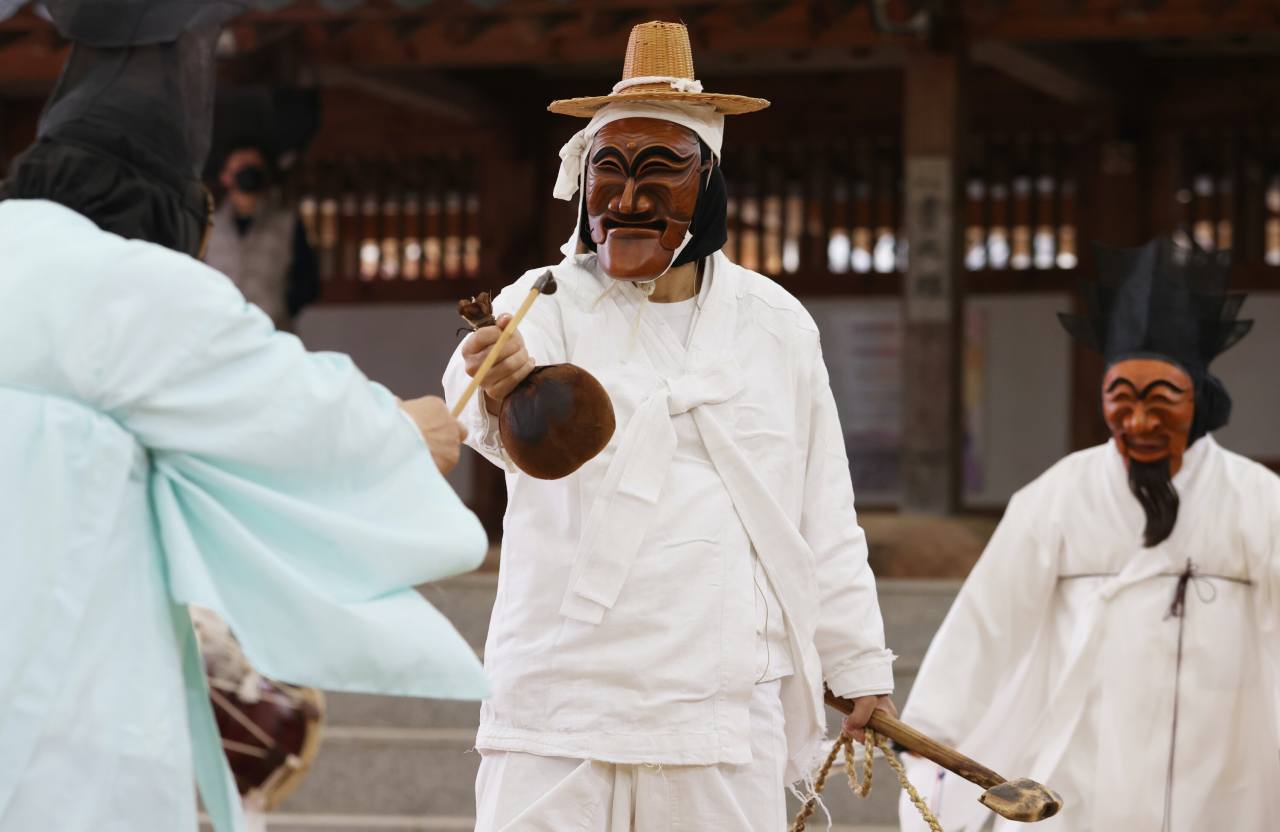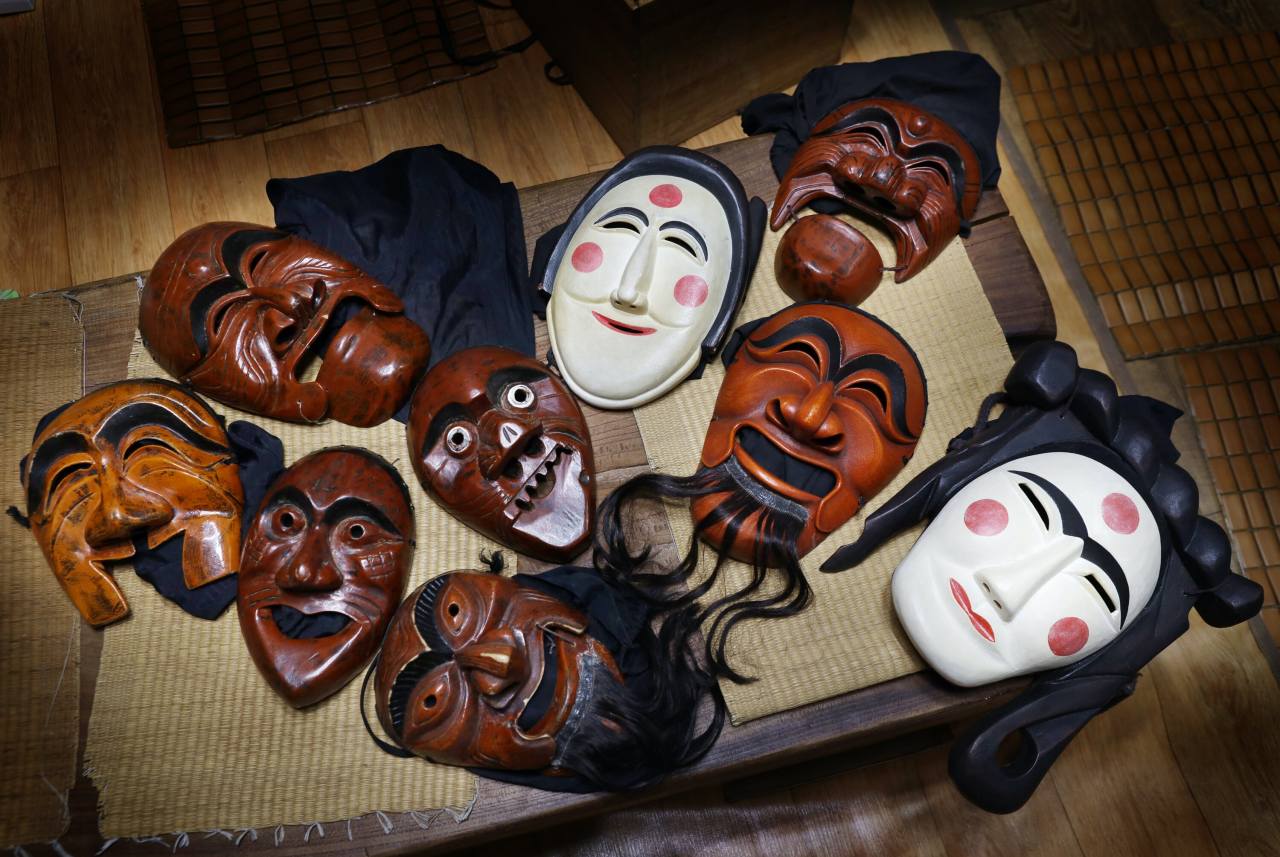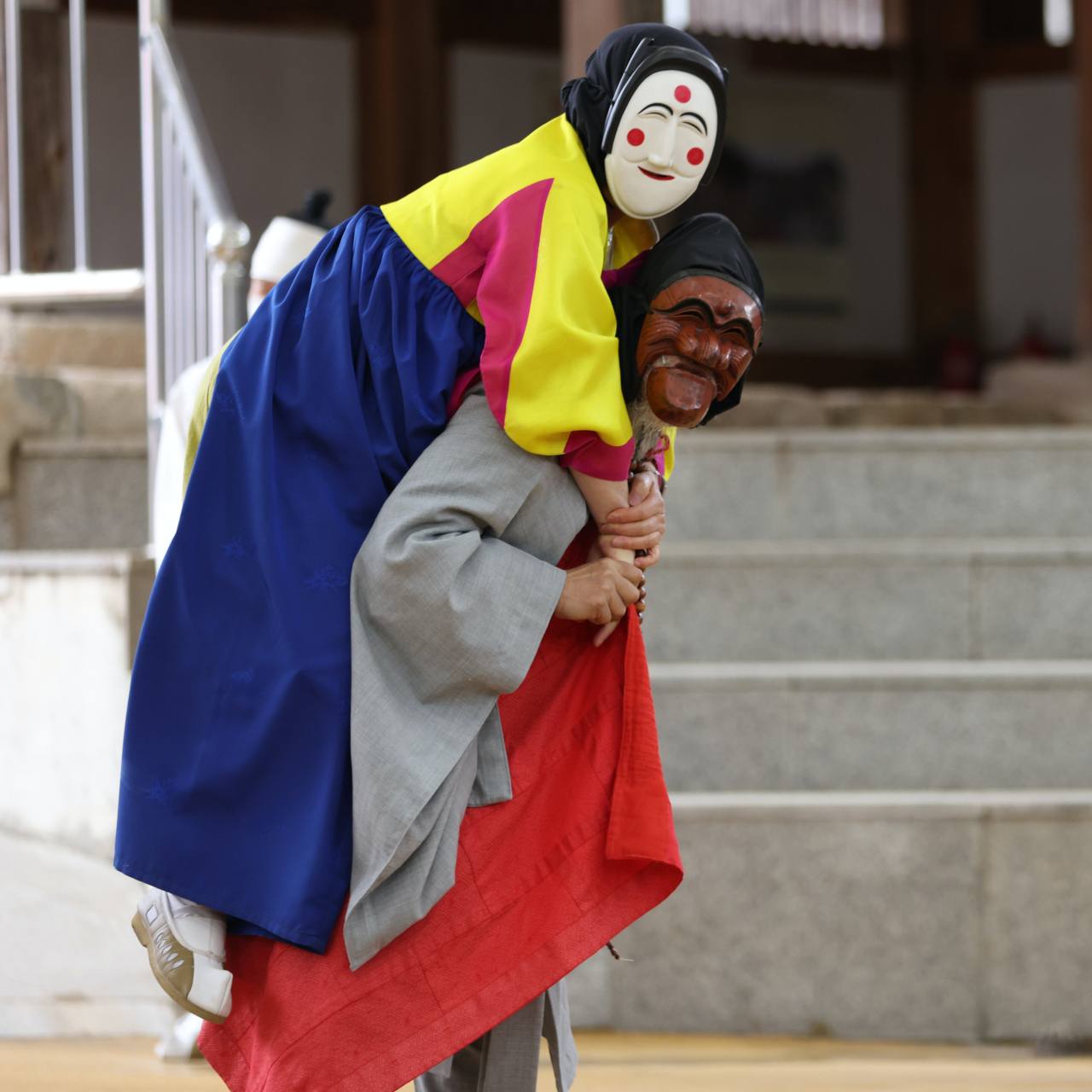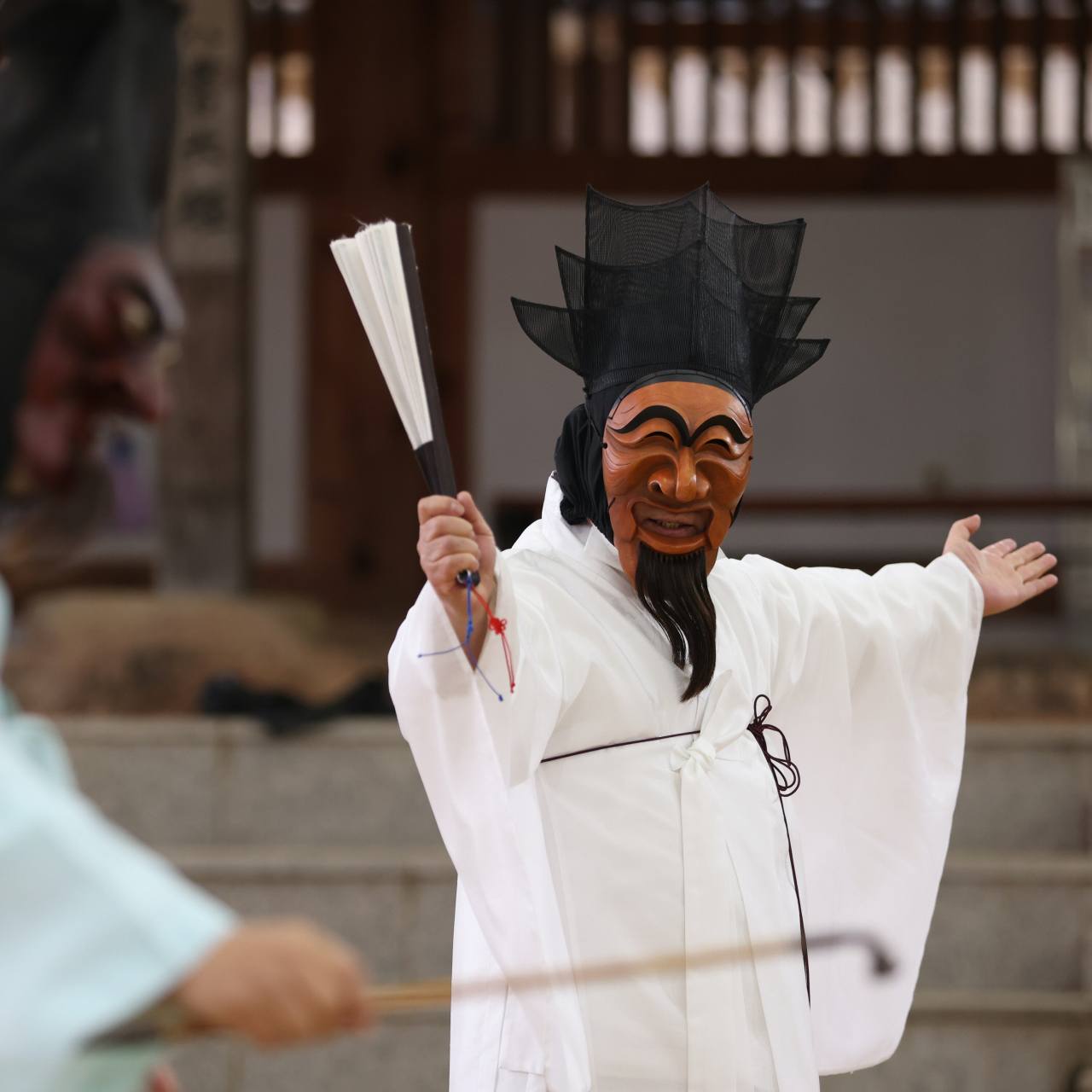 |
The butcher (center) tries to sell bull’s testicles to the scholar (left) and the nobleman during a Hahoe Byeolsingut Talnori mask dance in the Hahoe village of Andong, North Gyeongsang Province. Photo © Hyungwon Kang |
Humor has been the essential grease that nourishes life’s joy for ordinary Koreans.
Among many humorous Korean music and performing arts, Andong Hahoe Byeolsingut Talnori, or the Hahoe mask dance, gives performers the courage to say and do a multitude of outrageous things at the expense of the social elite.
Nine surviving masks from the Goryeo Kingdom, some 900 years ago, combine to make National Treasure No. 121. They represent the monk, nobleman, scholar, butcher, bride, Bune the entertainer, granny, Choraengi, the servant to the nobleman, and Imae, the servant to the scholar.
Interestingly, only four masks -- monk, nobleman, scholar and butcher -- have moveable jaws, giving their characters’ the freedom of speech.
An American diplomat left a firsthand observation of the butcher, “baekjeong” in Korean, in the 19th century.
 |
Kim Jong-heung, 67, Hahoe’s sanju, or village spiritual leader, holds a bride mask in Hahoe, Andong, North Gyeongsang Province. Photo © Hyungwon Kang |
“These men are pariahs in Korean society, as are butchers, tanners and grave diggers, or others who handle dead things. All were well over six feet (183 centimeters) tall. One of them was florid in complexion with red hair, red bushy beard and bright blue eyes,” wrote William Franklin Sands (1874-1946), who worked in Korea in the 1890s documenting Korea in his 1930 memoir, “Undiplomatic Memories: The Far East 1896-1904.”
The Silla Kingdom had a caste system, and when Silla gave way to the Goryeo Kingdom in 918, it inherited a nomadic people who performed socially undesirable tasks such as animal butchery. The butchers were part of the social outcasts called “Yangsucheok.”
King Sejong the Great named the Yangsucheok nomads the “baekjeong” class, akin to “untouchables,” and integrated the bandits and nomads into the mainstream of the Joseon era, which was a mostly agrarian society. Hence, during the Joseon era, baekjeong became a common noun defining a group of nomadic people as well as the occupation of butchers.
 |
Hahoe Byeolsingut Talnori masks are displayed on a table in Hahoe, Andong, North Gyeongsang Province. Photo © Hyungwon Kang |
Researchers believe the nomadic baekjeong butchers were originally former Khitan and Jurchen people. Khitans have their roots in the nomadic people of Mongolia and Jurchens were East Asian Tungusic-speaking peoples.
Baekjeong, or butcher, in the Andong Hahoe mask dance belittles the upper social class elites, the yangban (nobleman), seonbi (scholar) and a Buddhist monk. Buddhist monks had considerable clout in the Goryeo Kingdom as Buddhism was the state religion, as it was for the Silla Kingdom.
In the mask drama-dance, the butcher makes fun of the nobleman and the scholar for wanting to buy bull’s testicles, which is introduced as an aphrodisiac.
None of the masks have facial features that are symmetrical, giving each character unique and often conflicting looks depending on the direction from which they are viewed.
The nobleman mask has more lines on one side of his face when he asserts his authority and age, while the other side has fewer facial lines, to project youthful vigor when he courts Bune, the female entertainer.
While there are 13 traditional mask dances in Korea, the Andong Hahoe masks are made with real wood and are not burned after each performance, as is the case in other Korean mask dances.
 |
Monk and Bune masks are seen during a performance of the Hahoe Byeolsingut Talnori in Hahoe, Andong, North Gyeongsang Province. Photo © Hyungwon Kang |
The Andong Hahoe Talnori is based on a legend about a Huh family bachelor from the Goryeo Kingdom who was praying to save a village from persistent famine and a pandemic.
Huh was inspired to please the “seonangsin,” or village gods, with a mask dance to eradicate the famine and disease sweeping the area.
“Bachelor Huh was to make 12 masks in seclusion for 100 days without seeing his 17-year-old girlfriend from the Kim family from a neighboring village. But on the 99th day, his girlfriend crossed the line and peeped into the workshop and locked eyes with Huh. He became cursed and died spitting blood. Huh’s girlfriend took her own life to follow Huh,” said Kim Jong-heung, 67, the current “sanju,” or spiritual leader, of the small village of Hahoe in North Gyeongsang Province.
“A hut for seonangsin has been built to remember the Huh-Kim couple’s love story,” said Kim. An annual winter memorial rite called “dongje” is held at dawn of the first full moon of each new year in the name of the couple, Kim added, explaining it is held to console the unrealized love and pray for the well-being of the village.
The responsibility of the village spiritual leader means having a spiritual connection to the village gods, according to Kim, who has served in his post as sanju for 27 years.
 |
An actor performs wearing the nobleman mask in the Hahoe Byeolsingut Talnori in Hahoe, Andong, North Gyeongsang Province. Photo © Hyungwon Kang |
The gaksi, or bride, mask has a sealed mouth, one eye looking down with no ears, a reflection of advice given to newlywed daughters “to turn a blind eye for three years, be deaf for three years and be mute saying nothing for three years,” said Kim.
The female entertainer, Bune, mask has a sliver of an opening for the mouth, while the granny mask has a sizable opening, reflecting social tolerance for elderly women speaking out as they are considered to have earned the right to express their opinions.
The mask of Choraengi, servant to the nobleman, is considered like the equivalent of a modern-day journalist. There is nothing straight about his facial features, with a crooked mouth and a facial expression that looks docile on the side facing the nobleman, but angry and discontent from the audience’s side. The crooked mouth is a literal representation of the old saying, “Speak straight even if you were born with a crooked mouth.“
The mask of Imae, the servant, has no jaw. Bachelor Huh died not finishing the 10th mask when he was visited by his girlfriend who missed him too much.
The bride mask’s unusual hairstyle is found on a Baekje Gilt-bronze Bodhisattva statue, a visual clue to the ancient nature of the Andong Hahoe masks.
“During the last two dongje, I prayed for the departure of the COVID-19 pandemic. In order to receive the village gods as the official spiritual leader of the village, for many days before the dongje, I stay pure by refraining from visiting a funeral home or meeting sick people, and stay away from my wife,” Kim said.
By Hyungwon Kang (hyungwonkang@gmail.com)
---
Korean American photojournalist and columnist Hyungwon Kang is currently documenting Korean history and culture in images and words for future generations. -- Ed.By Korea Herald (
khnews@heraldcorp.com)










![[Herald Interview] 'Trump will use tariffs as first line of defense for American manufacturing'](http://res.heraldm.com/phpwas/restmb_idxmake.php?idx=644&simg=/content/image/2024/11/26/20241126050017_0.jpg)
![[Exclusive] Hyundai Mobis eyes closer ties with BYD](http://res.heraldm.com/phpwas/restmb_idxmake.php?idx=644&simg=/content/image/2024/11/25/20241125050044_0.jpg)
